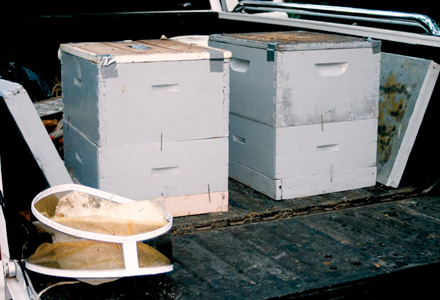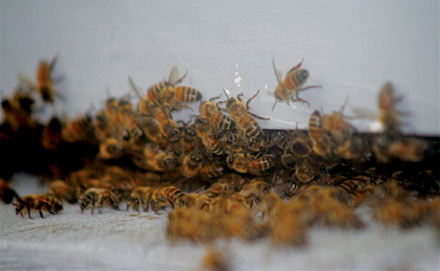California-Bound Honeybees

The first winter after I started keeping honeybees, I received a call from someone who asked if I wanted to move my bees to California to pollinate almond fields. I was new to keeping bees but the offer was intriguing. It had never occurred to me how almonds got pollinated, let alone that bees, some years as many as 3/4ths of all bee colonies from around the country, moved to California for a few short weeks to pollinate the thousands of almond trees.
One of the articles I read said last year there would have been a shortage of bees to pollinate the almonds had it not been for the California drought.
How much would they pay me per hive, I had asked the caller. It was an impressive amount, although at the time I was not comfortable even with the thought of letting Gertrude and Mildred, my hives named after my Mom and Grandmother, even out of my sight.
The caller asked if my hives had been moved to other fields. Many beekeepers, he said, periodically moved their hives to provide pollination services. I assured him my girls had only been pollinating my garden and had been under my watchful eye the whole time they had been with me.
This was 2011, several years before small hive beetles were found in hives in the Missouri County where we live. Then wax worms and viruses associated with varroa mites were the main bee pests and disease threats, although I had not yet met the little red vampire-like mites.
Varroa was one of the three main threats to honeybees nationwide. Combined with poor nutrition because of the lack of a variety of flower sources and over-exposure to pesticides, bees had been on rapid decline since 2006.
When he asked how many hives I had, I confessed, only two. But if they were going out west, I said, I was going with them. We all travelled first class.
He laughed. He had found me through my beekeeping blog and was trying to find beekeepers to get more bees out west. I said I appreciated the offer but I thought it was best that we should stay in the Midwest for now.
Exposure to new diseases, changing weather conditions and increased stress on the bee colonies have been among the factors cited for cutting down, if not stopping, the practice of moving bees long distance for pollination. Not to mention what less pollination would do to the lucrative commercial almond market. Eighty percent of the world’s almond supply is grown in California.
Since then, there have been online discussions about the impact of moving bees around the country half a year. After pollinating almonds, bees move to Texas to pollinate apples and peaches, then out east to pollinate blueberries and cranberries.
Maybe it’s time to mediate our almond consumption and appreciate the local nuts we can grow. After all, bees can pollinate those, not have to travel as far and it minimizes their exposure to stress and diseases.
Charlotte Ekker Wiggins is a beekeeper, gardener and sometimes cook. Published by El Dorado Springs Sun once in print and online with author’s permission. Copyright 2017, all rights reserved. This column may not be reprinted, republished or otherwise distributed without author’s permission. Contact Charlotte at gardeningcharlotte at gmail dot com.

My bee hives would be sealed up like this, marked and join other hives to pollinate California almond fields had they travelled west. Instead, they were headed to my garden.

My first honeybees settling into their new home in my garden in 2011 instead of traveling out west to pollinate almonds. (Photos by Charlotte Ekker Wiggins).



Facebook Comments